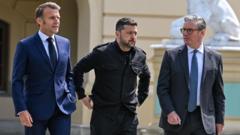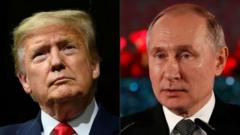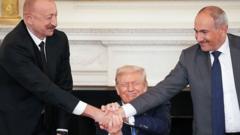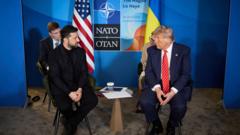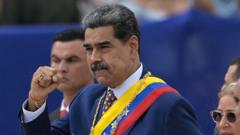*Despite President Trump's economic tactics to influence Russia's war strategy, the Kremlin's financial resilience raises doubts about the effectiveness of sanctions.*
**Trump's Economic Strategy Faces Challenges Against Russian Resilience**

**Trump's Economic Strategy Faces Challenges Against Russian Resilience**
*As diplomacy and tariffs collide, the Russian economy stands firm amid external pressures.*
In a bold move to halt Russia's ongoing conflict in Ukraine, President Trump has embarked on a dual approach comprising diplomacy and economic sanctions. This week, Trump announced an upcoming meeting with President Vladimir V. Putin, coinciding with his warning to impose an additional tariff on India for its continued oil trade with Russia. The U.S. President's strategy hinges on pressuring Russia’s economic structure, focusing on crippling its oil revenue as a means to end the war. Although economic conditions have worsened since the onset of the conflict in 2022, the Kremlin has shown resilience despite Trump’s threats.
The Russian economy, initially bolstered by increased state funding after the invasion, is now experiencing a growth slowdown, projected at only 1-2% this year compared to 4.7% in 2024. The oil revenue, which remains a lynchpin of its economy, has seen an 18% decrease, leading to an anticipated budget deficit rise from 0.5% to 1.7% of GDP. Analysts suggest the government will manage this shortfall through its sovereign wealth fund and military spending, which has persisted at roughly 8% of GDP.
Elvira Nabiullina, head of the Central Bank of Russia, expressed that the economy is transitioning to more sustainable growth, aided by cautious consumer and business spending that has mitigated inflationary pressures. Notably, recent studies indicate that living standards for many Russians have reached their highest in a decade, despite the toll of the war. That said, this economic strength may mask latent vulnerabilities, particularly in the oil sector, which is directly targeted by Trump’s sanctions.
Trump’s strategy includes threats of tariffs on nations like India, which has become a key player in Russian oil purchases. However, Indian officials have indicated they plan to continue buying oil from Russia, irrespective of potential tariffs, suggesting that the economic pressures intended to deter Russian aggression might not come to fruition. The broader implications of oil price fluctuations indicate that even a significant drop would only marginally affect Russia's capability to sustain its military endeavors.
In summary, while President Trump aims to leverage economic pressure to sway the Kremlin, Russia’s steadfast financial management presents a formidable challenge. As the meeting between the two leaders approaches, the international community watches closely for signs of change or continuity in this complex geopolitical landscape.
The Russian economy, initially bolstered by increased state funding after the invasion, is now experiencing a growth slowdown, projected at only 1-2% this year compared to 4.7% in 2024. The oil revenue, which remains a lynchpin of its economy, has seen an 18% decrease, leading to an anticipated budget deficit rise from 0.5% to 1.7% of GDP. Analysts suggest the government will manage this shortfall through its sovereign wealth fund and military spending, which has persisted at roughly 8% of GDP.
Elvira Nabiullina, head of the Central Bank of Russia, expressed that the economy is transitioning to more sustainable growth, aided by cautious consumer and business spending that has mitigated inflationary pressures. Notably, recent studies indicate that living standards for many Russians have reached their highest in a decade, despite the toll of the war. That said, this economic strength may mask latent vulnerabilities, particularly in the oil sector, which is directly targeted by Trump’s sanctions.
Trump’s strategy includes threats of tariffs on nations like India, which has become a key player in Russian oil purchases. However, Indian officials have indicated they plan to continue buying oil from Russia, irrespective of potential tariffs, suggesting that the economic pressures intended to deter Russian aggression might not come to fruition. The broader implications of oil price fluctuations indicate that even a significant drop would only marginally affect Russia's capability to sustain its military endeavors.
In summary, while President Trump aims to leverage economic pressure to sway the Kremlin, Russia’s steadfast financial management presents a formidable challenge. As the meeting between the two leaders approaches, the international community watches closely for signs of change or continuity in this complex geopolitical landscape.


